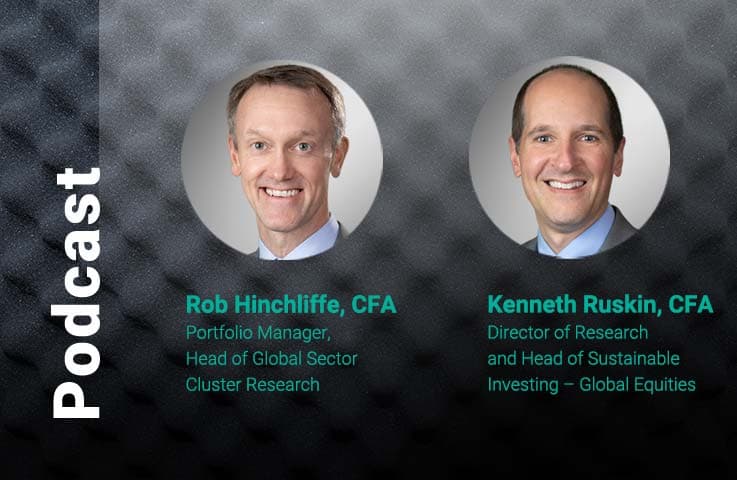2023 Midyear Equity Outlook: Three Capex Themes Driving Alpha

Rob Hinchliffe, CFA
Portfolio Manager, Head of Global Sector Cluster Research

Kenneth Ruskin, CFA
Director of Research and Head of Sustainable Investing – Global Equities
Near-shoring and “friend-shoring” are gaining traction, which should benefit industrial companies, including US-focused manufacturers, as well as banks and consumer product companies in countries such as India and Mexico that are benefiting from supply chain shifts.
Increasing factory automation to address tight labor is boosting related suppliers, including IoT (Internet of Things) and machine vision technology providers, which are enhancing automation and plant efficiency, along with industrial automation and industrial software companies.
Net-zero spending is ramping up, giving a boost to companies that help clients meet related goals, including heating and air conditioning product makers, mining equipment manufacturers, rail and rail equipment providers, and electric vehicle battery manufacturers.

While there is no shortage of concerns about the equity markets, first-quarter earnings exceeded expectations, with companies better able to pass through cost increases than many anticipated. Companies in the consumer staples and discretionary categories are among those with the best recent results, with consumer spending remaining strong and overturning expectations of a slowdown.
With inflation moderating and central bank hiking cycles likely nearing an end, the MSCI All Country World Index has risen 20% since October 2022 and 7.5% year to date.1 Yet underneath the overall rise is a nuanced picture, with risk assets (especially in financials) selling off and safer assets climbing.
Looking toward the second half of 2023 and beyond, our focus is on secular themes that could create mispriced opportunities in companies set to benefit from longer-term trends. Volatility continues to present compelling investment opportunities spanning the equity markets, and we see long-term potential in companies supporting or benefiting from three key areas of capital investment: near-shoring, automation, and net-zero emissions.
Key Convictions
1. Near-shoring is gaining steam – and companies that support or benefit from it look compelling.
Years of trade wars and Covid-related supply disruptions have caused companies to rethink their distributed supply chains and to bring operations closer to home and to end consumers. Among the countries driving and benefiting from this trend toward near-shoring or “friend-shoring” are the US along with Mexico, India, and Vietnam, to name just a few.
Strategic industries such as semiconductors and batteries are leading the charge. Over $250 billion of investments in near-shoring are expected over the next five years in the US alone.2 Construction spending on manufacturing rose significantly in 2022, and this is a leading indicator for increased US manufacturing production in the future. The semiconductor builds by themselves have the potential to increase US manufacturing capex by 4% annually for the next five years.3
While the clearest beneficiaries are industrial companies, including US-focused manufacturers, the related benefits for countries driving this trend – including higher consumer spending and economic growth – may create opportunities beyond industrials. These include, for example, banks and consumer product companies in countries such as India and Mexico that are benefiting from near-shoring and supply chain changes.
Construction Spending Related to Manufacturing Is Rising Sharply

Source: US Census Bureau as of 31 December 2022. Figures from 2002 on include public as well as private spending.
2. Increasing factory automation to address tight labor provides tailwinds to related suppliers.
Companies are increasingly interested in automation as hiring labor becomes more difficult and expensive. Moreover, the near-shoring movement requires greater automation to ensure that product costs don’t rise due to higher labor costs in the US and other developed markets. US industrial equipment and manufacturing plants in particular require significant automation upgrades following decades of under-investment in manufacturing.
Direct beneficiaries of this trend include IoT (Internet of Things) and machine vision technology providers, which are enabling more automation and plant efficiency, along with industrial automation companies. Industrial software companies also stand to benefit from this increased emphasis on automation and productivity.
3. Net-zero spending is ramping up, giving a boost to companies that help clients meet these goals.
An estimated $30 trillion needs to be spent over the next 15 years to reach net zero by 2050.4 An example of this spending in action is the EU’s “Fit for ’55” program, which the EC estimates will require €275 billion of additional investment annually to build energy renovation projects through 2030 – which could triple the rate of building renovations in the EU. Similar programs are being implemented in the US with infrastructure and Inflation Reduction Act (IRA) spending.
Segments set to benefit from this trend include heating/air conditioning products makers, mining equipment manufacturers, rail and rail equipment providers, and electric vehicle battery manufacturers, to name a few.
For more of our views on what investors and markets can expect in the second half, visit our 2023 Midyear Investment Outlook.
Footnotes
1 Source: FactSet as of 16 May 2023.
2 Source: UBS as of April 2023.
3 Ibid.
4 Source: IEA, Goldman Sachs Global Investment Research “Carbonomics” 16 June 2020. UN Climate Science Panel https://www.weforum.org/agenda/2021/05/what-exactly-is-net-zero-and-how-can-we-achieve-this-according-to-the-iea-s-roadmap/ RealClear Energy https://www.realclearenergy.org/2020/09/21/the_60_trillion_price_tag_for_a_net-zero_world_577866.html
Disclosure
Investing involves risk, including possible loss of principal. The information presented herein is for illustrative purposes only and should not be considered reflective of any particular security, strategy, or investment product. It represents a general assessment of the markets at a specific time and is not a guarantee of future performance results or market movement. This material does not constitute investment, financial, legal, tax, or other advice; investment research or a product of any research department; an offer to sell, or the solicitation of an offer to purchase any security or interest in a fund; or a recommendation for any investment product or strategy. PineBridge Investments is not soliciting or recommending any action based on information in this document. Any opinions, projections, or forward-looking statements expressed herein are solely those of the author, may differ from the views or opinions expressed by other areas of PineBridge Investments, and are only for general informational purposes as of the date indicated. Views may be based on third-party data that has not been independently verified. PineBridge Investments does not approve of or endorse any republication of this material. You are solely responsible for deciding whether any investment product or strategy is appropriate for you based upon your investment goals, financial situation and tolerance for risk.



